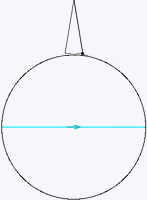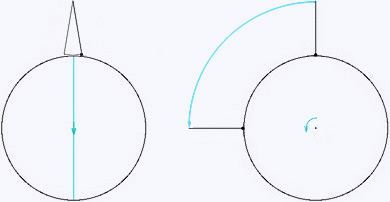The Foucault Pendulum
The Foucault pendulum was the first — and is still the best — demonstration of the fact that the Earth really does rotate.
When Copernicus first published his argument that the Earth rotates on its axis, it seemed like only a point of view. Whether the stars revolve around a stationary Earth or the Earth rotates against a stationary backdrop of stars was academic as long as there was no evidence favoring one point of view over the other.
Up until the 19th Century, most people thought the stars were small and the Earth large, so it was reasonable to think of the Earth as stationary and the stars as moving. Astronomers came to realize that the stars are large (and distant), so they were comfortable with the idea that the Earth rotates. Other people weren't convinced until Foucault demonstrated his pendulum, which makes the Earth's rotation visible.
![]() The key attribute of a Foucault pendulum is its ability to swing in any direction. This is usually accomplished by using a wire to suspend the bob. In addition, the pendulum is made long, and its bob heavy, to minimize the effect of air drag and air currents in the room.
The key attribute of a Foucault pendulum is its ability to swing in any direction. This is usually accomplished by using a wire to suspend the bob. In addition, the pendulum is made long, and its bob heavy, to minimize the effect of air drag and air currents in the room.
As the pendulum swings, the direction of its swing slowly changes. Because the rotation is very slow, most setups include some means of making its progress visible. For the pendulum at the Academy of Sciences in San Francisco, there is a circular row of pegs arranged so that the pendulum knocks them over, one at a time, as it rotates.
If you watch the pendulum for several minutes, especially when it closes in on the next peg and eventually knocks it over, you can perceive the rotation of the plane of its swing. Knowing that the pendulum is freely suspended, you may then be able to visualize it swinging steadily as the Earth rotates under it.
The slowness of the Earth's rotation helps explain why we are not aware of it unless we have the aid of the pendulum or some other phenomenon that is sensitive to it. (For example, British naval gunners in the Falklands War found their shells going to the left of their targets until they realized that the correction for the Earth's rotation in their gunnery tables needs its sign reversed when you're on the other side of the equator.)
 Here's a description of way the Foucault pendulum works. First, imagine a Foucault pendulum swinging over the North Pole. (In the diagram, the blue-green line represents the equator.) The pendulum keeps swinging in the same plane as the Earth rotates underneath it. An observer standing on the Earth sees the plane of the pendulum's swing rotate through a full 360 degrees in 24 hours.
Here's a description of way the Foucault pendulum works. First, imagine a Foucault pendulum swinging over the North Pole. (In the diagram, the blue-green line represents the equator.) The pendulum keeps swinging in the same plane as the Earth rotates underneath it. An observer standing on the Earth sees the plane of the pendulum's swing rotate through a full 360 degrees in 24 hours.
Now let's set up a pendulum at the equator. In the diagram on the left below, the blue-green line again represents the equator; the pendulum is swinging north and south. At this location, the pendulum continues swinging north and south as the Earth rotates.

The diagram on the right shows the equatorial pendulum as viewed along the direction its swing (looking south). From this point of view, you can see what's happening: As the Earth rotates, it tilts the pendulum's support. Because the pendulum is hanging freely, it always points down, so it follows the Earth's rotation. To an observer on the Earth, the pendulum remains vertical and the plane of its swing does not rotate.
As these examples show, the behavior of the pendulum depends on its location. At the pole, it rotates once per day; at the equator, it doesn't rotate at all. At other locations, the pendulum's behavior is somewhere in between: Its rate of rotation depends on the latitude. The period of rotation is given by
Tp = 24 / sin(Lp)
where
Tp is the time (in hours) for one complete rotation of pendulum and
Lp is the latitude at the location of the pendulum.
For a Foucault pendulum at the latitude of San Francisco (38 degrees), Tp is about 39 hours.
copyright © 2008 Allen Watson III